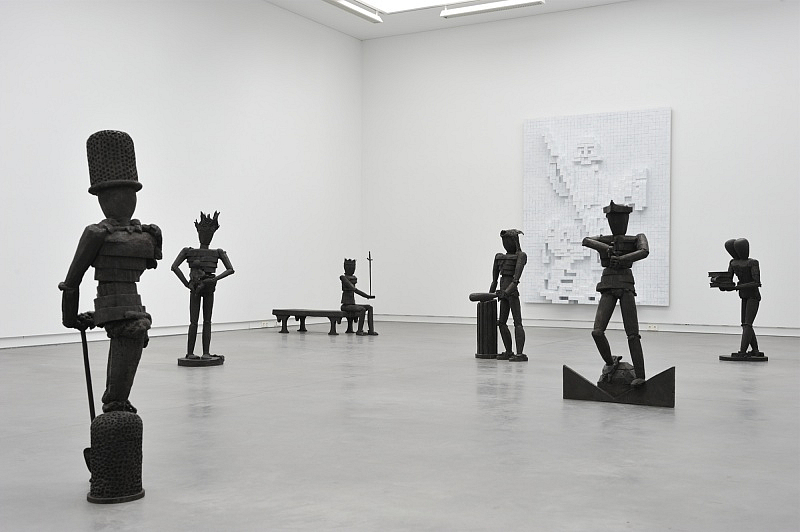Peer Veneman
The seven Virtues and some Saints
12 Sept - 1 Nov 2009
Peer Veneman (Eindhoven 1952) has been a strong representative of Dutch sculpture since the early 1980s. By that time, modernist sculpture was no longer 'in the picture'. Even the pedestals were gone. Alternatives, such as performance art, were beginning to wane. A new generation of sculptors had no other choice but to contemplate a way in which sculpture could reinvent itself. Peer Veneman did just that with considerable verve.
Now, thirty years later, Peer Veneman has given shape to an impressive body of work. One constant factor evident throughout that work is his apparent refusal, even in a single piece of sculpture, to do the same thing twice. Every element that goes into an artwork is carefully weighed by him beforehand. Being a sculptor, he starts with form; but that form has a surface, too, and exists within a spatial construction. He aims to give new meaning to sculpture (form), painting (the surface) and architecture (spatial construction). His works, made of very diverse materials, are therefore almost always painted or provided with some other type of worked surface, and they relate to each other spatially. One of his early sculptures—Wie schön ist die Natur (1983)—aptly illustrates that approach. This is a semi-abstract, semi-figurative sculpture in which that art form is reflected in a mirror provided by nature. The work resembles a plant-like insect looking at itself through its two differently faceted red eyes. Not only are the formal aspects of visual art questioned by Veneman in his work. His connotative intentions undergo that process as well. The subjects now raised by him in De Pont's project space clearly show this. As a contemporary artist he renounces, along with the 'eighties', the Catholic imagery with which he was brought up. Nevertheless he remains aware that he cannot simply ignore his cultural baggage. Because subjects such as sin and virtue continue to crop up in the moral and ethical dilemmas of his time, he examines the degree to which his views on them are culturally determined. Ten years ago he started on The Seven Cardinal Sins. This series of sculptures, each just over a meter in height, was shown at Galerie Onrust in Amsterdam in 1999. The typically medieval theme of man's inner struggle was transposed by Veneman, on the basis of existing religous imagery, into generally human contemplations on the forms that evil can assume. For that reason these works break with a certain art-historical tradition. A striking aspect is their great sense of gravity, though Veneman conveys this in an agile manner.
That agility in seriousness comes across even more emphatically in the presentation Seven Virtues and Some Saints.
Veneman based his ideas for this project on the book (from 1947) Symboliek en Iconographie der Christelijke Kunst by J.J.M. Timmers, in which the personifications of sins and virtues throughout the history of art are described in detail. Unlike The Seven Cardinal Sins, the sculptures of Seven Virtues have not initially been carried out in clay. Before being cast in bronze, the sculptures were constructed in styrofoam. A traditional dummy serves as the point of departure for each work. Like the 'sins', the 'virtues' are not lifesize but model-like in height. Although Veneman employs known Christian iconography, these are odd sculptures. This is due to his omission of some symbols from the Christian pictorial tradition and emphasis on others, but especially because of the candidness with which he allows us to see how each work has been put together. Every aid used by him, including tape and connective materials, remains visible in the smallest details. In the first edition of Timmer's book, the personification of 'Justice' is said to sit at the foot of a bed. That specification disappeared in a later edition. Veneman gives added dimension to the notion 'justice' by nevertheless using that bed in this work. He also loosely interprets excerpts from Timmer's book, as with the description of 'Caution', personified in several faces. For the sculptor these have become two separate heads. Veneman stresses the fact that such decisions can often be trivial, that they don't necessarily have huge significance to him. He combines his 'virtues' with reliefs of the four saints, a related theme since saints stand for certain virtues and good deeds. In developing the images of the saints, he worked from embroidery patterns found on a hobby website for 'patron saints in cross-stitch'. By transposing the indicated color schemes into differences in height, he made the simple cross-stitch technique sculptural. Here again he built the works with styrofoam, now cut into uniform cubes. These reliefs take the shape of lifesize maquettes. Saint George, for instance, measures 280 x 220 x 23 cm. As such the patron saints serve, in a twofold sense, as models for us to contemplate. We see, painted in acrylic, reliefs composed in a numerical structure that has provided Veneman with an unexpected result. In his work he discovers his own order. The keen observer will see that he has rearranged information from the past.
